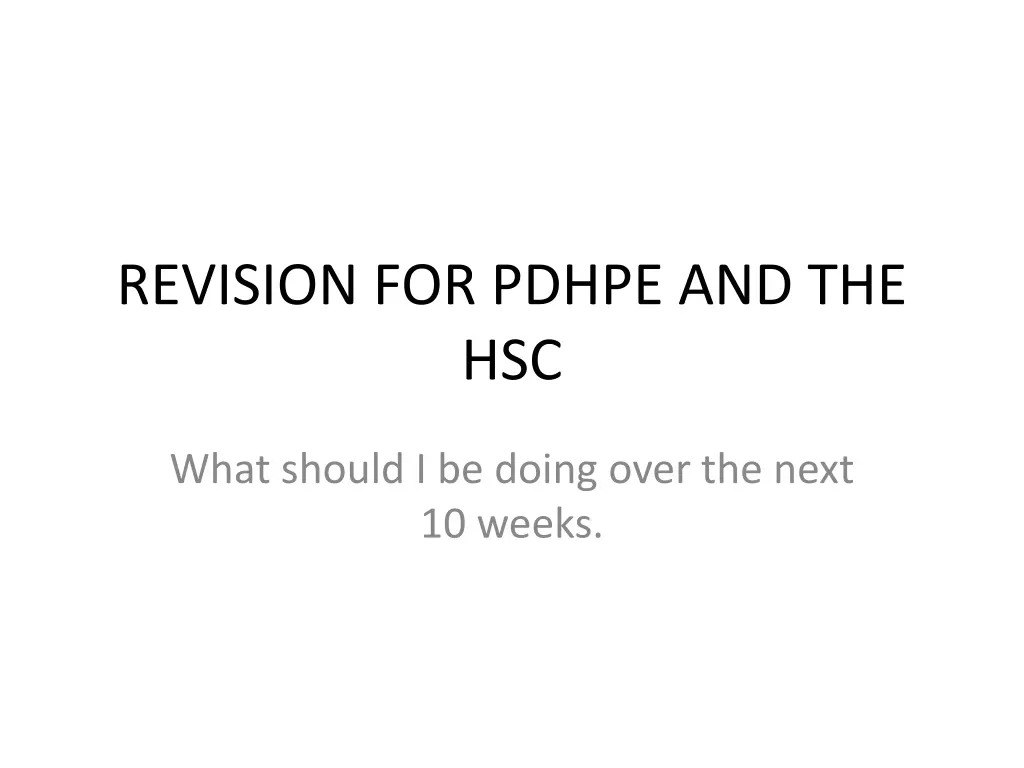
Strategies for PDHPE and HSC Exam Success
Prepare effectively for your PDHPE HSC exams with activities focusing on exam techniques, question breakdowns, and analysis of national health priority areas. Enhance your understanding of key concepts and optimize your study approach to succeed in the upcoming exams.
Download Presentation

Please find below an Image/Link to download the presentation.
The content on the website is provided AS IS for your information and personal use only. It may not be sold, licensed, or shared on other websites without obtaining consent from the author. If you encounter any issues during the download, it is possible that the publisher has removed the file from their server.
You are allowed to download the files provided on this website for personal or commercial use, subject to the condition that they are used lawfully. All files are the property of their respective owners.
The content on the website is provided AS IS for your information and personal use only. It may not be sold, licensed, or shared on other websites without obtaining consent from the author.
E N D
Presentation Transcript
REVISION FOR PDHPE AND THE HSC What should I be doing over the next 10 weeks.
Activity 1: Exam techniques questionnaire Answer to the the questions. How many questions are there in section 1 Part A of the HSC PDHPE paper? 20 What types of questions are in section 1 Part A of the HSC PDHPE paper? multiple choice The first half of these questions relate to which section of the PDHPE syllabus? Core 1 What mark value is Section1 part A of the HSC PDHPE paper? 20 marks How much reading time is allowed in the HSC PDHPE examination? 5 minutes What should you do during the reading time? Read all of the questions How much writing time is allowed in the HSC PDHPE examination? 3 hours Question 21 relates to which Core of the syllabus? Core 1 How many parts might Question 21 have? Up to 3 Questions 27-31 relate to which section of the PDHPE syllabus? Option modules How much time should you allocate to Question 22? About 1 hour 10 minutes How much time should you allocate to the multiple choice? Approx 40 minutes Where do I write my answers to the Core questions? On the exam paper Where do I write my answers to the Option questions? In the writing booklet How many option questions should I answer? Two options that I have studied How many markers read my answers? At least two How do they know what mark to give my answer? They use marking guidelines What happens if markers give different marks for my answer? It is called a discrepancy and then it is marked a third time Will the markers read or mark my plan? yes Am I penalised for writing information that is incorrect in my answer? NO
Activity 2 For each question below go through the process of breaking down the question by: Underlining the key word Circle the syllabus content Highlight the links or relationships that must be addressed in the question. Explain why injury and diabetes have been identified as national health priority areas. 8 marks (2008 HSC Exam) Analyse how building healthy public policy can address TWO national health priority areas you have studied. (2007 HSC Exam) 12 marks Explain how characteristics of the learner and the learning environment affect the acquisition of skill. (2007 HSC Exam 8 marks
Activity 3 In pairs, you are going to prepare a plan of attack to answer the following extended response questions from a previous HSC examination. Question 21 Describe the inequities of health status experienced by people of low socio economic status in Australia. (5 marks) Go through the following process to plan your attack: Read the question slowly at least twice Underline the key word/s in the question that tells you HOW to answer the question.
What does this key word require you to do to answer this question? Describe: Response requires main points with brief explanation of each and relevant example/s.
List the key areas of the syllabus to address when answering this question. Critical Question 2 - What are the priority issues for improving Australia s health? Students learn about: groups experiencing health inequities Aboriginal and Torres Strait Islander peoples socioeconomically disadvantaged people people in rural and remote areas overseas-born people the elderly people with disabilities Students learn to: research and analyse Aboriginal and Torres Strait Islander peoples and ONE other group experiencing health inequities by investigating: the nature and extent of the health inequities the sociocultural, socioeconomic and environmental determinants the roles of individuals, communities and governments in addressing the health inequities
Prepare a mind map of points to include in your response. Use arrows to highlight the links between syllabus content that need to be drawn out in your response.
Identify the links or relationships between syllabus content areas that need to be addressed
